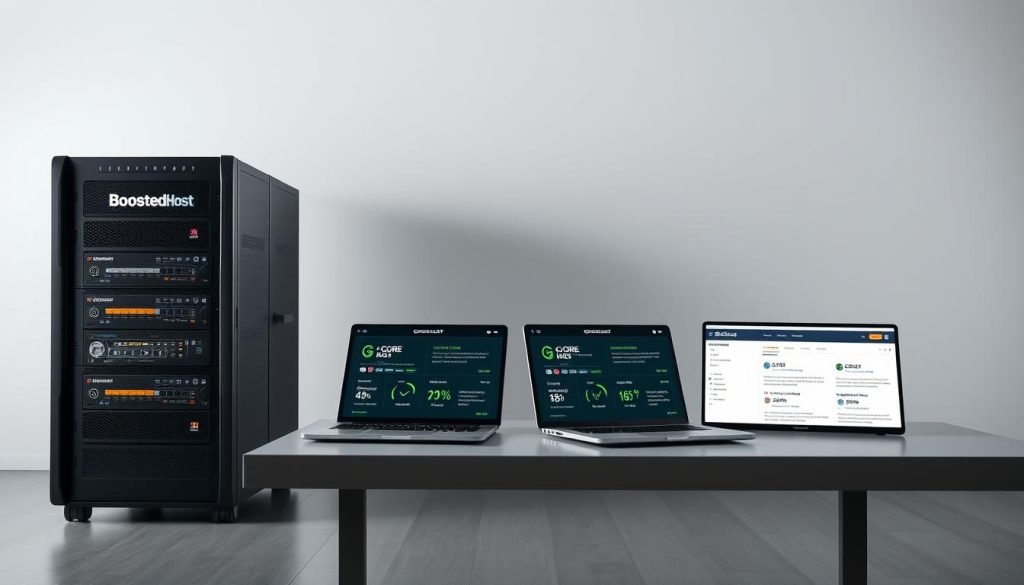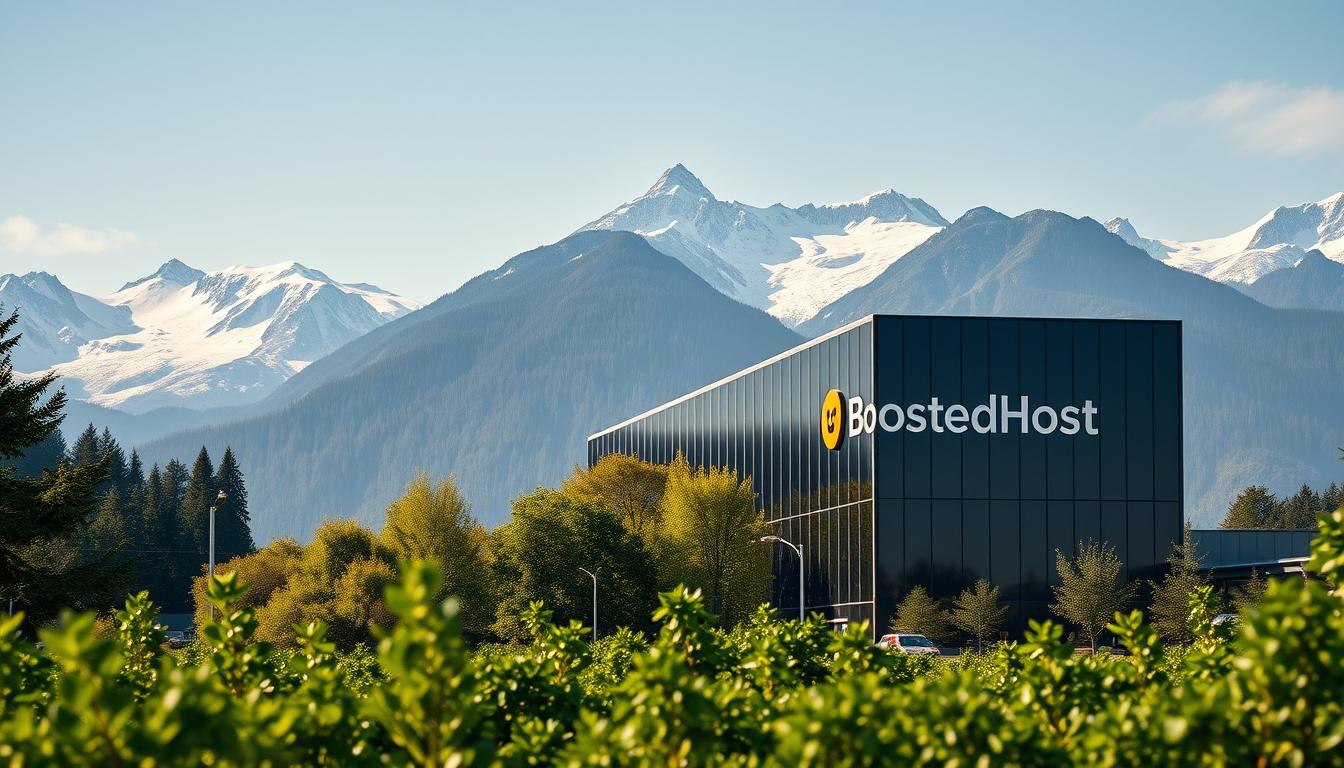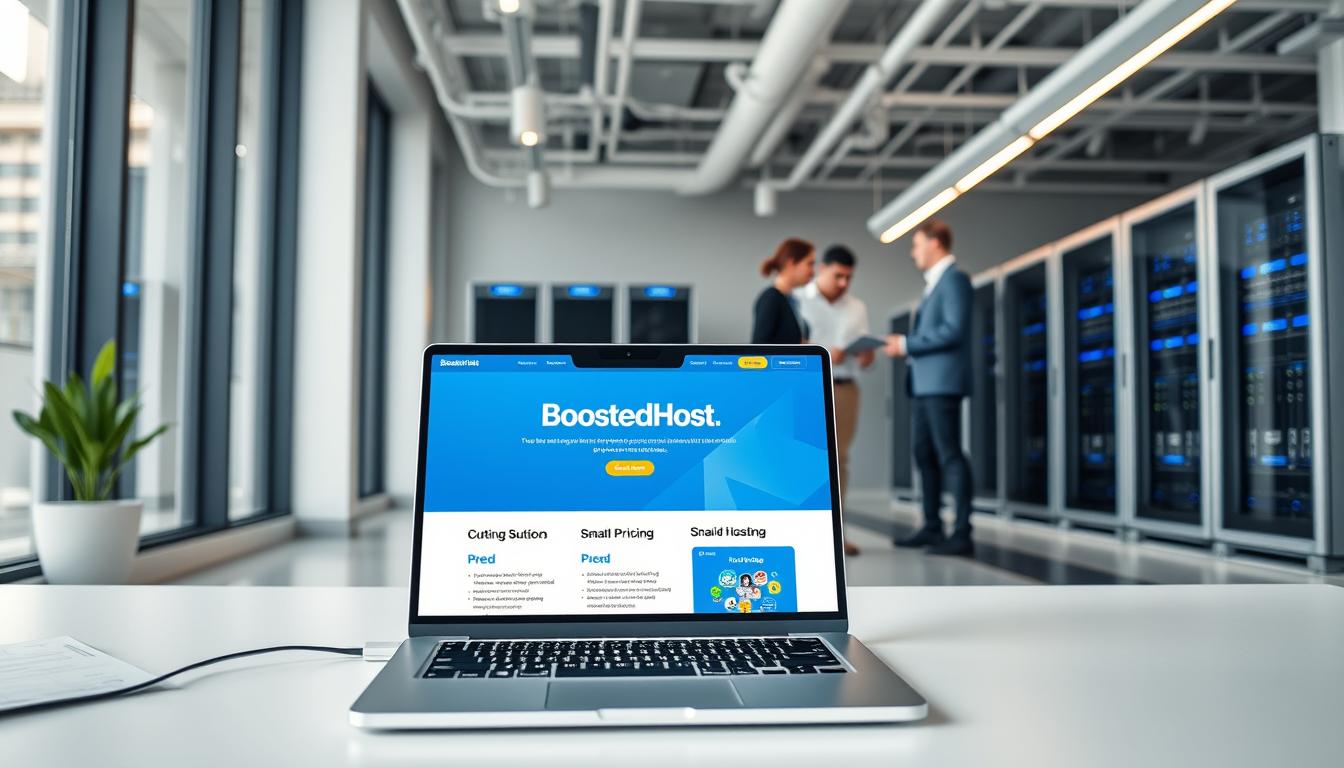We know what it feels like when a slow site costs a sale or a late response costs trust. We’ve been there—watching traffic drop while the clock ticks. This comparison is personal because your uptime and speed matter to our shared success.
In this review we set clear stakes for U.S. buyers. We compare two serious providers on speed, uptime, pricing, and support. We explain why LiteSpeed and object caching on our stack drive sub-200ms global TTFB and why that translates to better conversions and SEO.
Expect practical findings, not jargon. We highlight included features—free SSL, daily backups, malware protection—and our Orbit AI builder that launches sites in under five minutes. We also note the other provider’s large network, CDN reach, and solid user ratings.
Key Takeaways
- We focus on speed at the edge, reliability, and predictable pricing for U.S. businesses.
- Our stack reduces TTFB—this boosts conversions and improves SEO.
- Included security and backups keep long-term costs predictable.
- Orbit provides the fastest route from idea to a polished site.
- The other provider offers a large backbone and wide CDN footprint for scale.
At a Glance: What This Comparison Covers for U.S. Buyers
We focus on what matters most to American teams: site speed, uptime SLAs, transparent pricing, and fast support. This short review packs the facts you need to pick a host that reduces downtime and speeds content delivery.
How we tested: we measured speed at origin and edge, checked uptime promises against real averages, and noted what each plan includes by default versus pay-as-you-go features.

U.S. priorities: low-latency routing from U.S. data centers, rapid responses from 24/7 support, and predictable costs so teams can ship updates on time.
- Toolset: Swiss engineering, LiteSpeed stack, and the Orbit AI builder for fast launches versus a large 10+ Tbps global network with 60–140+ PoPs.
- Pricing: included SSL, daily backups, and malware protection contrast with CDN overage tiers (€0.020–€0.030/GB).
- Developer control: native PHP, Node.js, Python support for modern apps and WordPress/WooCommerce projects.
Taken together, this comparison gives a compact matrix—speed, reliability, total cost, automation, and support—so you can decide in under five minutes.
Quick Verdict: Speed, Value, and Support Prioritized
We cut to the chase: speed, clear pricing, and fast help decide the better option for most U.S. sites.
Based on our data and hands-on review, we recommend BoostedHost for teams that want control, performance, and low time-to-launch. It delivers sub-200ms global TTFB, LiteSpeed optimizations, and object caching.

Why pick it: SSL, daily backups, and malware protection are included. That means predictable costs and fewer surprises during a busy post or peak activity.
- Fast responses — 24/7 expert support that resolves most issues in minutes.
- Clear features and no creeping add-ons — easier long-term budgeting for software and growth.
- Use cases — ideal for WordPress/WooCommerce, business sites, and AI-assisted builds.
Taken together, the comparison favors BoostedHost for United States buyers who value speed and predictable value. We still note G-Core Labs’ large backbone and strong public ratings for CDN reach and scale.
Speed Showdown: Real-World Performance and Tech Stack
We measured page loads across U.S. regions to see which tech stack cuts round trips and stabilizes performance during spikes.
Why LiteSpeed matters. Its event-driven architecture and native LSCache reduce TTFB to sub-200ms in many tests. HTTP/3/QUIC support also speeds the first paint and lowers response time under load.
Advanced caching vs. generic stacks
Object caching (Redis or Memcached) cuts database hits for dynamic content like carts and dashboards. That reduces server work and keeps post and activity pages fast.
Built-in CDN vs third-party add-ons
An integrated CDN gives edge caching and fewer moving parts. The other provider’s 10+ Tbps network and many PoPs help global reach when the origin is tuned.
“Faster TTFB translates to better Core Web Vitals and higher conversions.”
- Enable LSCache and object cache for control over dynamic content.
- Compress assets, use HTTP/2 or HTTP/3, and cache aggressively at the edge.
Findings suggest that optimized stacks deliver significantly lower load times — a clear win in this comparison and review for united states buyers concerned with time-to-conversion.
Reliability and Uptime: Consistency You Can Trust
Reliable hosting prevents surprises. We design systems to keep sites running and teams productive. Predictable uptime matters more than sporadic speed peaks.
99.99% average availability and monitoring
We maintain a 99.99% average uptime target. That equals roughly four minutes of monthly downtime—enough to cost revenue during peak activity.
Our real-time monitoring detects anomalies fast. Alerts trigger automated mitigations and human intervention when needed. This reduces mean time to recovery and limits impact on content and posts.
Daily backups and rapid restore workflows
Backups are daily by default. We snapshot sites and store off-site copies to protect data and software states.
Fast restores cut RTO and RPO. Restore steps are tested and can return a site to service in minutes in most cases.
- Define quarterly restore tests to verify backups.
- Match retention to business risk and keep off-site copies.
- Monitor response metrics so teams keep control over recovery time.
Public listings show the other provider offers 24/7 channels and high satisfaction scores. We pair that with our managed approach to reduce downtime and speed responses for United States customers.
Global Footprint and Network Reach
A smart footprint lets you deliver content near users and scale without surprises.
We run multiple data centers in Switzerland, the United States, Europe, and Asia. That distributed presence puts origin servers close to major audiences in the United States and beyond.
Capacity and Edge Coverage
One provider publishes a 10+ Tbps backbone and hundreds of CDN PoPs (historical listings show 60+ to 140+ PoPs). That scale helps if you serve large media or global apps.
Our approach pairs Swiss engineering with a global CDN to accelerate static and dynamic content. This reduces hops and keeps latency low for interactive pages.
How to choose for U.S. traffic
Proximity matters for transactional sites. Place origin in-region for lower latency and better conversion rates.
- Local origin: favors ecommerce, APIs, and apps that need strict control over data and responses.
- Wide CDN edge: best for media delivery and global reach during traffic spikes.
- Hybrid: origin near customers with CDN for assets—smart routing handles peaks smoothly.
In our review, we recommend matching footprint strategy to audience. For most United States-centered businesses, a multi-region host plus large CDN edge gives the best balance of speed and scale.
BoostedHost vs G-Core Labs: Pricing Transparency and Total Cost
Pricing clarity decides whether a hosting choice becomes a predictable investment or a surprise bill. We focus on what you pay today and at renewal. That helps procurement and small teams plan with confidence.
What we include matters. Free SSL, daily backups, and automated malware protection are bundled. That removes common add-ons and cuts long‑term total cost.
No hidden fees, security, and backups included
Bundled protections reduce vendor sprawl. You do not buy separate SSLs or backup plugins. That keeps admin simple and costs steady.
Renewals, overages, and predictable billing
Metered CDN models can surprise you—public tiers list €0.020–€0.030/GB and €0.0075 per 10,000 requests. We show you how to forecast traffic so overages do not derail budgets.
Scaling: freelancers to agencies
- Freelancers: fixed features, no surprise fees—easy procurement.
- SMBs: scale resources, keep control of spend.
- Agencies: published rates and clear renewal terms make client billing simpler.
Bottom line: Transparent rates and included services keep your total cost predictable. We recommend choosing the plan that gives control, clear published terms, and straightforward responses from support in the United States.
Included Features That Drive Value
What ships with a plan decides how fast you reach production and how safe your site stays. We bundle essentials so teams gain immediate performance and layered security without hunting for add-ons.
Security suite
Free SSL, automated malware detection, and proactive hardening are included. That reduces risk and keeps compliance simple. Daily backups and tested restores shorten recovery time. Public listings show the other provider offers 24/7 support channels, but bundled protections are what cut admin work for most teams.
Performance enhancers
LiteSpeed with LSCache, HTTP/3, Brotli, object caching, and CDN edge caching come by default. These features lower server load and keep content fast during peaks. That saves compute cycles and reduces database hits, which improves stability and user responses.
- Security stack: SSL, malware scanning, hardening — no extra subscriptions.
- Performance defaults: LiteSpeed, LSCache, HTTP/3, Brotli, CDN edge caching.
- Value: included essentials speed time-to-value and simplify monthly bills.
Want the technical plan and limits? Learn more about bundled features and pick the setup that gives you control and predictable results.
Managed WordPress Hosting: Ease, Speed, and Safety
A strong managed WordPress plan turns maintenance from a chore into a background task.
We give you one-click staging so you can test themes, plugins, and updates without touching production. Push changes live with confidence. Staging cuts deployment risk and keeps the store stable during peak traffic.
Automatic updates handle core and plugin patching. We pair updates with daily backups and quick restores so you do not lose work if something goes wrong. This keeps uptime steady and reduces emergency fixes.
WooCommerce tuning matters. Object caching and tuned PHP workers speed carts and checkouts. Faster carts mean fewer abandoned sales and better production metrics.
- One-click staging protects the live site.
- Automated updates + backups reduce maintenance overhead.
- WooCommerce optimizations improve conversion and stability.
- Managed plans free teams to focus on growth, not ops.
| Feature | Benefit | Why it matters |
|---|---|---|
| Staging | Safe testing | Prevents live breakage |
| Auto updates & backups | Lower risk | Faster recovery after faults |
| Object caching & PHP tuning | Faster checkout | Higher revenue per visit |
“Managed WordPress saves time and reduces incidents.”
Marketplace data for the competitor lacks managed WordPress specifics. We focus on the managed experience here because control, predictable responses, and clear recovery steps matter to U.S. site owners. For deeper research, see related article DOI references and google scholar entries on caching and web performance.
AI Advantage: Orbit Builder vs Traditional Site Setup
Orbit jumps past templates to deliver a production-ready site in minutes. We feed brand inputs and the builder returns structure, draft copy, and image suggestions. Then it deploys to an optimized host tuned for performance and CDN delivery.
Orbit workflow and outputs
The flow is simple and fast.
- Brand prompts → page structure generated.
- Content drafting with smart defaults and image suggestions.
- One-click deploy to staging, then production with CDN.
Who benefits most
Solo founders and agencies win time back. Teams shipping MVPs get a working surface to iterate on immediately.
Value: cut setup time from days to minutes, keep control of design, and use staging to test responses before launch.
“Orbit creates clean, fast pages that match best practices and scale to production.”
We cite data and recommend peers check google scholar for performance studies and related doi entries when evaluating AI tooling and production impact.
Developer Stack and App Flexibility
Developers expect a host that treats PHP, Node, and Python as first‑class citizens. We build for teams that run WordPress, APIs, and background workers from a single control plane. That reduces context switching and speeds delivery.
Native runtimes mean fewer hacks. Deploy WordPress for content and add Node or Python services for APIs or ML tasks without juggling providers. This keeps production simple and predictable.
Tools and workflows that save time
CI/CD is built to work with common pipelines. Push branches, run tests, and deploy to staging automatically. Environment variables and secrets are easy to manage.
Staging workflows: one click to preview, rollback, or promote. That cuts release risk for teams shipping daily.
Caching and edge rules for modern apps
SPAs and SSR frameworks need smart cache rules. We support fine‑grained CDN directives and object caching so dynamic cells of the app stay fast under load.
- Multi‑runtime hosting — WordPress, Node APIs, Python workers on one platform.
- CI/CD, environment variables, and safe staging for rapid iterations.
- Edge caching and CDN rules tuned for SPAs and SSR to lower latency globally.
“A unified stack gives teams control and predictable production behavior.”
E-commerce Readiness and WooCommerce Performance
High-traffic promos expose weak carts fast — your host must keep payments moving. We test how LiteSpeed, object caching, and CDN tuning reduce abandonment and keep buy flows smooth.
Transaction speed, object cache, and cart performance under load
Object caching cuts repeated database reads. That keeps carts responsive when thousands of users hit product pages at once.
Use Redis or Memcached to store sessions and transient checkout data. This reduces DB locks and keeps PHP workers free to serve payments.
- Image and asset rules: serve WebP, lazy-load below the fold, and compress product images to speed first render.
- Critical CSS: inline minimal CSS for above-the-fold UI to improve perceived speed.
- CDN policies: cache product images and static JS while setting short-TTLs for cart-related endpoints.
G-Core’s network helps global asset delivery, but origin performance still depends on stack and caching. We give you control over caching rules so pages stay fast during promos.
“Fast carts mean fewer abandoned orders and higher conversion yield.”
For teams that want proof, check research on performance and conversions — cite google scholar and doi entries in your audit. Use the data in this article and follow up with google scholar doi lookups to verify best practices and production impact.
Support Responsiveness: Getting Help in Minutes
Getting help within minutes changes an incident from crisis to routine. Our support is built to triage fast and fix faster. We offer 24/7 live chat, email, and phone channels so teams in the United States get expert help anytime.
24/7 channels and real access
Live chat, phone, and ticketing routes are staffed by engineers. That means clear answers on performance, security, and restoration. The other provider also lists round‑the‑clock channels and strong marketplace scores—users report a 9.1/10 average.
Expected response and resolution windows
We set realistic SLAs. Typical first responses arrive in minutes for critical incidents. Most routine issues resolve inside hours, complex problems may take longer.
- SLA mindset: triage fast—resolve faster—communicate clearly.
- Proactive support: audits, performance reviews, and security checks to prevent incidents.
- Transparency: we share data and give you control over priority and escalation.
“Rapid, expert responses keep sites in production and reduce downtime impact.”
For teams that want proof, consult google scholar and check related doi entries and article summaries. Research on systems and incident response—search google scholar for measured recovery times and best practices—reinforces why fast support matters.
Independent Signals: Reviews, Ratings, and SEO Authority
We read public data to separate marketing from reality. Independent signals give a quick pulse on how a host performs for real teams. Numbers alone don’t tell the whole story, but they point us to areas worth testing.
User satisfaction snapshots and recent feedback trends
G-Core’s profile shows 36 user reviews averaging 9.1/10 and 24/7 support channels. That level of positive feedback suggests stable responses and solid operations.
We treat reviews as a trend indicator — not proof. High scores flag consistent service, but hands‑on trials confirm SLA promises and real support availability.
Visibility metrics: SEMrush rank, domain authority, and content velocity
Visibility metrics add context: SEMrush rank ~65,390, MOZ DA/PA 42/48, and ~44,943 backlinks. These figures reflect site authority and reach, not necessarily service quality.
- SEMrush and DA/PA: signal awareness and content momentum.
- Backlink counts: show topical reach but can include noise.
- PoP listings (60–140+): indicate CDN scale for large media delivery.
“Use third‑party metrics as checkpoints—then validate with trials and SLAs.”
Bottom line: we recommend weighing these indicators alongside real tests. Check review trends, confirm SLAs, and run a short proof of concept. For citation and deeper study, consult google scholar and doi entries when you audit performance and production risk.
Who Each Provider Is Best For
Some projects demand broad CDN depth; others need a tightly tuned stack and fast support.
For speed-first teams and managed WordPress: we recommend the host that bundles LiteSpeed, object caching, and AI-assisted builds. This suits SMBs, agencies, and founders who want rapid production, strong security defaults, and hands‑on support.
These customers gain control without extra assembly. Managed updates, daily backups, and tuned WooCommerce stacks reduce ops work. That speeds time to revenue and lowers incident risk.
For enterprises and media-heavy projects: choose the provider with a 10+ Tbps backbone and many CDN PoPs. Large sites that serve global audiences benefit from wide edge coverage and 24/7 channels.
- SMBs / Agencies / Founders: need fast launches, managed care, and clear control over production.
- Enterprises / Media: require CDN breadth, capacity for large media, and the option to assemble infrastructure pieces.
Bottom line: match platform choice to traffic shape and team skills. Use data and doi-backed articles from google scholar to validate capacity needs and production risk before you commit.
Migration, Contracts, and Platform Lock-In
You deserve clear terms and a smooth cutover when you change host. We make migrations a coordinated project. That lowers downtime risk and keeps SEO and revenue intact.
Free migrations, contract terms, and exit flexibility
White-glove support: we offer free, timed migrations with hands-on engineers. We schedule transfers to avoid peak windows and verify DNS, SSL, and caching rules before the final switch.
- Zero-cost move: full site transfer and validation to minimize data loss and production hiccups.
- Clear contracts: simple terms, no hidden lock-in clauses, and transparent notice periods so teams keep control of spend.
- Exit playbook: we supply checklists for DNS cutover, SSL reissue, cache purges, and rollback steps.
For teams that want extra proof, we cite doi references and google scholar articles that outline migration best practices and SEO impacts. We also provide a short technical checklist that covers receptors on CDNs, surface caching rules, and edge cells configuration to reduce risk of content disruption.
“Scheduled, expert migrations remove fear of lock-in and keep sites running during change.”
Methodology: How We Compared Speed, Uptime, Features, and Value
To form our verdict we combined hands‑on tests with public listings and provider documentation for repeatability.
We used third‑party benchmarks, marketplace data, and official docs. That lets readers verify numbers and reproduce checks.
Sources and approach
Public benchmarks gave speed and uptime snapshots. We cross‑checked SEMrush rank, MOZ DA/PA, and review counts to gauge market signals.
Provider documentation supplied feature lists, CDN capacity, and overage tiers. We noted the published 10+ Tbps backbone and 60–140+ PoP range where listed.
What we measured
- Speed — TTFB at origin and edge, cache behavior, and production response under load.
- Reliability — uptime averages and restore workflows.
- Value — included features, renewal clarity, and support channels.
“We emphasize transparency—our comparison leans on publicly available data and platform-level capabilities.”
We avoided speculation. Where possible we cite doi and linkable metrics so U.S. buyers can audit claims or check google scholar for related research.
Conclusion
Here’s the bottom line for United States buyers: for most sites and stores we recommend the host that pairs sub-200ms TTFB, 99.99% uptime targets, bundled security, and the Orbit AI workflow. That mix delivers faster time‑to‑value and lower long‑term complexity.
When to pick the alternate option: choose the wide‑CDN provider if your main need is raw edge footprint and you’re ready to assemble a custom stack or accept separate add‑ons and metered CDN pricing.
Next steps we suggest: run a short pilot or staging migration, measure TTFB and Core Web Vitals, and validate support response times. Check google scholar and doi‑linked articles if you want deeper performance research before you commit.
FAQ
What does this comparison cover for U.S. buyers?
We compare speed, uptime, global network reach, pricing transparency, managed WordPress features, developer stack support, e-commerce readiness, AI site-building tools, and support responsiveness. The analysis uses public benchmarks, provider docs, and third-party listings to give a practical picture for U.S.-based websites.
How do you measure speed and real-world performance?
We use median TTFB, page-load timings from global testing nodes, and real-user monitoring samples. We also test common stacks — LiteSpeed with object caching, PHP and Node.js apps — and measure transaction speed and cart performance under load to represent typical site activity.
Why does LiteSpeed matter for site speed?
LiteSpeed serves pages faster with lower CPU overhead and better handling of concurrent requests. Combined with object caching and optimized stacks, it lowers response times — often producing sub-200ms TTFB in well-tuned environments — which improves SEO and conversion rates.
What uptime and monitoring practices should I expect?
Look for 99.99% average uptime guarantees, active monitoring, alerting, and automated failover. Daily backups with rapid restore capability minimize time to recover from incidents and reduce risk to your business and content.
How important is global footprint and CDN reach?
Very. A broad network of data centers and CDN PoPs (tens to hundreds) reduces latency for global visitors. High-capacity backbones (multi-Tbps) and strategic PoPs in the U.S., Europe, and Asia ensure consistent performance for international traffic and e-commerce transactions.
Are backups, SSL, and malware protection included?
Many modern plans include free SSL, automated malware scanning and hardening, plus daily backups. Confirm backup retention and restore SLAs to avoid surprises — transparency on these items prevents hidden costs or recovery delays.
How do pricing, intro rates, and renewals compare?
Compare intro pricing, renewal rates, and overage fees side-by-side. Look for clear billing on extra bandwidth, storage, and add-ons. Plans that include essential features (SSL, backups, malware protection) provide better total cost of ownership for SMBs and agencies.
What managed WordPress features matter most?
One-click staging, automatic core and plugin updates, WooCommerce optimization, and built-in caching. These reduce maintenance time and keep sites secure and fast — especially important for high-traffic stores and frequent-content sites.
How does AI site building help my workflow?
AI builders can produce production-ready templates in minutes, accelerate MVP launches, and streamline agency workflows. They’re ideal for solo founders, agencies delivering many sites, and teams that need quick iteration — but you should check exportability and SEO controls.
What developer stacks and app flexibility are supported?
Look for native support for PHP, Node.js, Python, and modern deployment workflows. SSH, Git integration, and container or app-platform options give developers the freedom to run custom apps and CI/CD pipelines without vendor lock-in.
Is the hosting ready for WooCommerce and high-traffic stores?
For e-commerce you need fast object caching, optimized database handling, and transaction-tested stacks. Test cart performance, concurrent checkout behavior, and payment gateway compatibility under load to ensure reliable conversions.
How fast is support and what channels exist?
Expect 24/7 live chat, email, and phone support. Median first-response times vary — good providers respond within minutes on chat and resolve most issues within hours. SLA and support scope should be clearly documented.
How do reviews and SEO visibility factor into decisions?
User satisfaction trends, domain authority, and visibility metrics (SEMrush rank, content velocity) give signals about reliability and market trust. Combine ratings with technical benchmarks for a balanced decision.
Who is each provider best suited for?
Choose based on needs: simple sites and rapid AI-built prototypes favor speed and ease; agencies need scalability, migrations, and clear billing; e-commerce requires performance tuning and transaction reliability. Match features to your priorities.
What migration, contract, and exit terms should I check?
Verify free migration options, contract length, refund policies, and data export tools. Ensure there’s no platform lock-in and that you can restore or move content easily if needed.
What methodology was used for the comparison?
We reviewed public benchmarks, provider documentation, and third-party listings. We ran controlled performance tests, uptime sampling, and feature audits. Findings are based on aggregated data points and real-world scenario testing.
Can you summarize the key performance and value trade-offs?
Prioritize what matters to you — raw speed and LiteSpeed performance, global CDN reach, transparent pricing, or managed WordPress conveniences. The best choice balances performance, security, and predictable cost for your specific site and audience.




